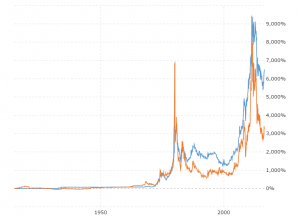Have Gold and Silver Reached the Bottom?
The old adage, “Buy low and sell high” sounds simple enough. But where is ‘high’ and where is ‘low’? These are the questions that keep investors and speculators awake at night. When it comes to coins, collectors have the advantage of a value based on more than the price of the metals in them, but historically some coins are rare precisely because at some point in the past people sold large quantities of them to realize the metal value, so collectors are not immune to profit taking either.
For some time now, the prices of gold and silver have been in steady decline. Silver is at its lowest price since 2011, and gold since 2012, so is this a time to buy? No one can predict the future, and we can only blame ourselves if we make a wrong call, but an interesting comment has emerged from someone who might know a little more about it.
The Professional Numismatists Guild is a non-profit organization of the top coin dealers and experts in America and internationally. The typical dealer has 25 years of experience, and he or she is bound by a professional code of ethics to show ‘knowledge, integrity and responsibility’. Within this organization is a sub-group, called the Accredited Precious Metals Dealers, bound by the same code. So when not just any member, but the President of that group speaks, perhaps their opinion is worth a little more than that of the average pundit.
Speaking specifically about pre-1934 gold coins, Barry Stuppler, that President, said recently that the spread between the intrinsic value and market value of those coins was the smallest it has been in 20 years. Why is this interesting? The ‘intrinsic value’ of a coin is also called the ‘melt value’, a term that makes its meaning clearer. Take a coin, melt it down into a piece of its constituent metal, be that gold, silver, or something else like platinum, and how much is that chunk of metal worth today, based on the current commercial price being paid for the metal? This should not be confused with the ‘face value’, which is the value stamped on the coin in dollars, or whatever is the legal tender of the country issuing the coin.
So what is the ‘market value’? That’s easy – it’s the price it will cost you to buy an actual coin of this metal today. If the market value falls below the melt value, many people will rush out and sell their coins for metal, and so make a profit. What Mr. Stuppler is pointing out is that it will only take a small rise in the price of gold or silver to reach that point, where the coin you buy today is worth more as metal than as a coin. Based on that, it might be reasonable to assume that the market recognizes that gold is getting too cheap, especially considering global uncertainties and the gathering trade wars. He thinks that we are already at the low point for 2018, which, if you believe that, suggest that now is the time to buy.
We will continue this discussion next week, with an explanation of what is so special about those ‘pre-1934’ coins.








